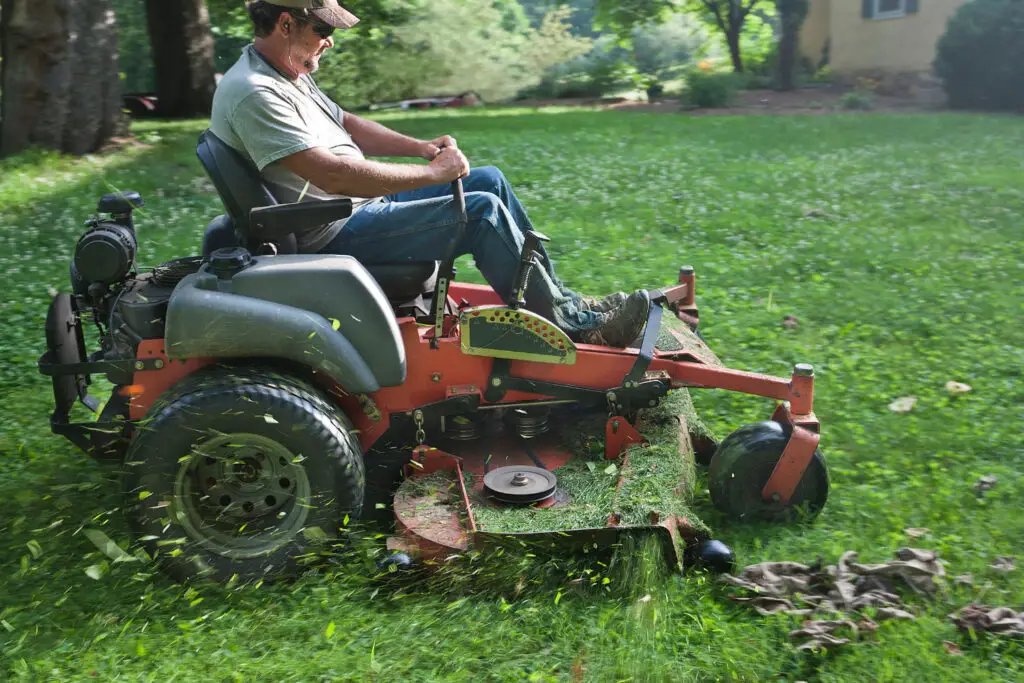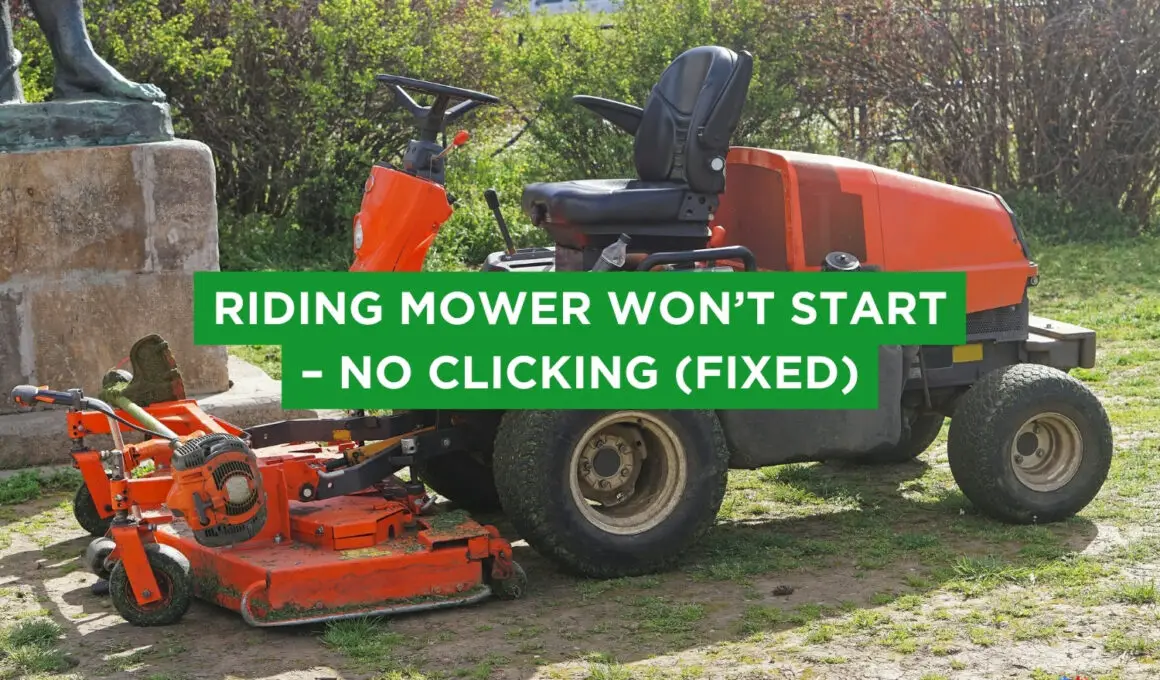In This Article Show
I’m here to help you solve a common problem many lawn owners encounter – a riding lawn mower that simply won’t start with no clicking sound. This issue can be a real headache, particularly when you’re prepared for a productive day of yard work and your reliable machine decides to go silent.
But fret not! Over the years, I’ve encountered this problem multiple times and have honed my troubleshooting skills to quickly identify the root cause and implement effective solutions. Whether you’re a seasoned gardener or a beginner, this guide will provide you with valuable insights into your riding lawn mower’s ‘no clicking’ issue.
While my expertise extends across various facets of lawn care and maintenance, I have a particular interest in empowering my readers to tackle technical issues with their equipment.
In-depth Examination of the ‘No Clicking’ Issue
When your riding lawn mower refuses to start and doesn’t produce the usual clicking sound, you may feel a bit baffled. But don’t worry, this issue is not as cryptic as it seems.
The clicking sound you usually hear when you attempt to start your mower is typically generated by the starter solenoid. This component plays a crucial role in your mower’s starting system by acting as a large switch that sends current from the battery to the starter motor. The clicking sound is the solenoid moving to close the electric circuit and start the mower.
So, when your riding lawn mower doesn’t start and there’s no clicking sound, it often indicates a problem within the starting system, most commonly with the starter solenoid or the ignition switch. As we’ve discussed in the previous section, both these components can be tested using a multimeter, and if faulty, they need to be replaced.
Get Gardening For Beginners
Our new EBOOK shows newcomers and green thumbs alike a step by step guide to growing the garden of their dreams.
Steps to Fix a Riding Lawn Mower That Won’t Start with No Clicking

Here are the steps to follow when your mower isn’t starting and you’re not hearing the clicking sound:
1. Check the Battery
First, ensure that your mower’s battery is not dead or drained. A weak battery may not be able to supply enough power to the starting system, causing the absence of a clicking sound.
2. Inspect the Ignition Switch
As we discussed earlier, a faulty ignition switch could prevent the starting system from receiving power. Use a multimeter to check the continuity of the switch in its different positions (Off, On, Start).
3. Examine the Starter Solenoid
If the ignition switch checks out, the issue likely lies with the starter solenoid. The solenoid can fail due to burnt contacts, a broken coil, or other mechanical faults. You can use a multimeter to test for continuity or voltage across the solenoid’s small terminals when the key is in the Start position.
4. Check the Wiring
Lastly, don’t forget to inspect the wiring connecting these components. Look for loose connections, corroded terminals, or damaged wires that might interrupt power flow.
Remember, it’s important to handle these components and tools carefully, and when in doubt, don’t hesitate to contact a lawn mower repair professional.
Identifying Common Issues of a Riding Lawn Mower Not Starting
With more than a decade of hands-on experience dealing with all sorts of lawn care equipment issues, I’ve come across a multitude of reasons why a riding lawn mower might refuse to start. If you find yourself faced with a silent, non-starting mower, it’s crucial to remember that this frustrating experience is usually due to a handful of common problems. Let’s take a look at these:
Get Gardening For Beginners
Our new EBOOK shows newcomers and green thumbs alike a step by step guide to growing the garden of their dreams.
1. Out of Fuel or Stale Fuel
It may seem obvious, but you’d be surprised how often this issue is overlooked. An empty fuel tank is the simplest reason your mower won’t start. On the other hand, if your mower has been idle for a long time, the fuel in the tank might have gone stale, which can prevent your mower from starting.
2. Faulty or Dirty Spark Plug
The spark plug plays a pivotal role in starting your mower by igniting the fuel-air mixture in the engine. If it’s dirty or damaged, it may not create the necessary spark to start the mower.
3. Clogged Carburetor
The carburetor regulates the flow of air and gas into the engine. If it gets clogged with dirt or debris, the engine might not get the right fuel mixture to start.
4. Dead or Weak Battery
The battery is essential for initiating the start sequence in electric-start mowers. A dead or weak battery may not provide the necessary power to kick-start the engine.
5. Faulty Ignition Switch
The ignition switch is responsible for starting the mower when you turn the key. If it’s faulty, the electrical signal to start the engine will not be sent.
How to Troubleshoot a Riding Lawn Mower That Won’t Start
While the above issues are fairly common, a distinct problem that can be particularly baffling is when the riding lawn mower won’t start with no clicking sound. This sound (or lack thereof) often points to issues with the starter system, which we’ll examine in detail in this section.
1. Checking the Fuel System
The fuel system is the first thing you should check when your mower refuses to start. It might sound simple, but even the most experienced gardeners sometimes forget to refill the fuel tank.
Start by examining the fuel level in your mower’s tank. If it’s empty, the fix is straightforward – fill it up with fresh gas. However, if there’s fuel, but the mower has been sitting idle for a long period, that fuel may have gone stale. Over time, gasoline can lose volatility and fail to ignite properly. It can also leave behind gummy deposits that can block the fuel system.
How to fix it If you suspect stale fuel, the best course of action is to drain it completely. You can do this by disconnecting the fuel line from the carburetor (ensure you have a suitable container to catch the fuel).
Once drained, refill with fresh gas. Regularly adding a fuel stabilizer can also help prevent the fuel from going stale. If the problem persists, you might have a blocked fuel line or filter, which will need to be cleaned or replaced.
2. Inspecting the Spark Plug
The spark plug is a crucial component that ignites the fuel-air mixture within the engine’s cylinder to start your mower. Over time, carbon buildup can occur on the spark plug, which can prevent it from sparking effectively.
How to fix it: First, disconnect the spark plug lead and clean the area around the spark plug to prevent debris from falling into the combustion chamber when you remove it. Using a spark plug socket, remove the spark plug and inspect it. If it’s dirty, try cleaning it with a wire brush and spark plug cleaner.
However, if you notice any physical damage or if the electrode is burned away, it’s time to replace the spark plug. When reinstalling, make sure to adjust the spark plug gap according to the mower manufacturer’s specifications.
3. Evaluating the Carburetor
The carburetor is responsible for mixing the right amount of air and gasoline for the engine to run. Over time, old fuel can evaporate in the carburetor, leaving behind a thicker, stickier substance that can clog the small holes of the carburetor.
How to fix it: If your carburetor is clogged, you’ll need to clean it. This can be a complex task as it involves removing and disassembling the carburetor, cleaning all the small parts with a carburetor cleaner, and then reassembling it.
Make sure to take pictures or make notes during disassembly to ensure everything goes back to the right place. If you’re uncomfortable doing this task yourself, it might be a good idea to take your mower to a professional.
4. Examining the Starter Solenoid
The starter solenoid plays a crucial role in starting your mower by triggering the starter motor when you turn the key. If it’s faulty, you might not hear the usual clicking sound when you try to start the mower.
How to fix it: To test the starter solenoid, you’ll need a multimeter. First, locate the solenoid (usually near the battery). Disconnect the small ignition wire from the solenoid and connect the red lead from your multimeter to the post where the wire was connected, and the black lead to the ground.
Set your multimeter to the DC volts setting (20 volts). Now, turn the key as if you’re trying to start the mower. If your multimeter shows no voltage, the solenoid is likely at fault and needs replacing.
5. Assessing the Ignition Switch
A faulty ignition switch could prevent your mower from starting. This switch sends the initial current from the battery to the rest of the ignition system when you start the mower.
How to fix it: To test the ignition switch, you’ll also need a multimeter. Disconnect the ignition switch from the circuit, and set your multimeter to the continuity setting.
For each position of the ignition switch (Off, On, Start), there are different combinations of connections that should have continuity, which can be found in your mower’s manual. If the readings don’t match up with those combinations, the ignition switch might be faulty and should be replaced.
Preventive Measures to Avoid Starting Problems with Your Riding Lawn Mower
While troubleshooting can certainly help you when you face a ‘no start, no clicking’ problem, prevention is always better than cure. By taking certain preventive measures, you can significantly reduce the likelihood of facing such issues with your riding lawn mower. Here are some strategies to keep your mower in top shape:
1. Regular Maintenance
Adhering to a regular maintenance schedule is one of the most effective ways to prevent most lawn mower issues. This includes changing the oil, replacing the air filter, and sharpening the blades regularly. You should also clean the mower deck to avoid the build-up of grass clippings and debris, which can cause a variety of problems.
2. Proper Storage
How you store your mower, especially during off-season months, can have a significant impact on its starting ability. Always clean your mower thoroughly before storing it for a prolonged period.
Drain or stabilize the fuel to prevent it from going stale. Disconnect the battery and store it in a cool, dry place to prevent it from draining.
3. Use Fresh Fuel
Always use fresh fuel in your mower. As discussed earlier, stale fuel can clog the carburetor and prevent your mower from starting. Adding a fuel stabilizer can help keep the fuel fresh for a longer period.
4. Regular Battery Checks
Perform regular checks on your battery’s health. Keep it clean, as dirt can drain battery power. If your battery is more than three years old, it might be a good idea to replace it even if it seems to be working fine.
5. Check Spark Plug and Ignition System
Regularly inspect the spark plug for any signs of wear or damage. Similarly, ensure the ignition system, including the ignition switch and the starter solenoid, are in good working condition.
Remember, a little care and attention can go a long way in keeping your riding lawn mower running smoothly, saving you from sudden breakdowns and the frustration of troubleshooting.
Wrapping it up
Lawnmower issues can be challenging, especially when they seemingly come out of the blue. When your riding lawn mower refuses to start, and there’s no clicking sound to hint at what might be wrong, it can leave you scratching your head in confusion.
However, as we’ve discussed in this article, even this ‘silent’ problem can be methodically diagnosed and often fixed right at home.
Remember that the key to successful troubleshooting lies in understanding the functioning of various components in your mower. From the fuel system to the ignition switch, each part plays a critical role in getting your mower started. Once you understand how these parts interact, diagnosing and fixing issues becomes significantly easier.
But perhaps the most important takeaway from this discussion should be the value of preventive maintenance. Regular upkeep and proper storage can prevent many common issues, ensuring that your mower remains ready for action whenever your lawn needs it.










